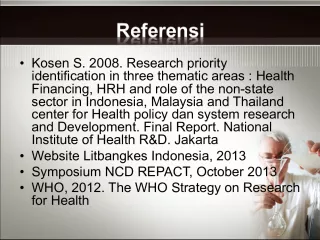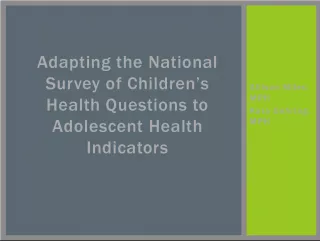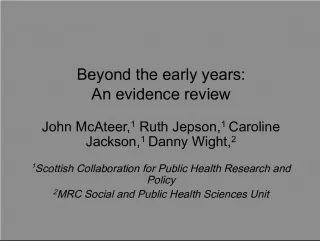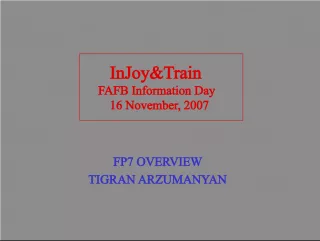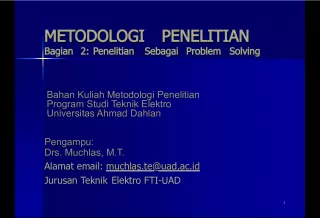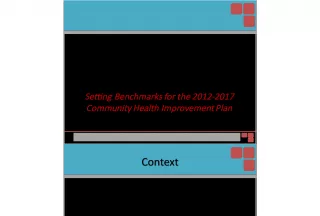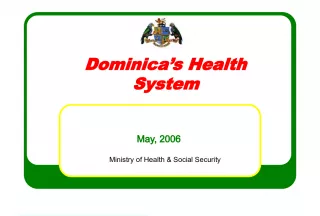Donald T SimeonCaribbean Health Research Council
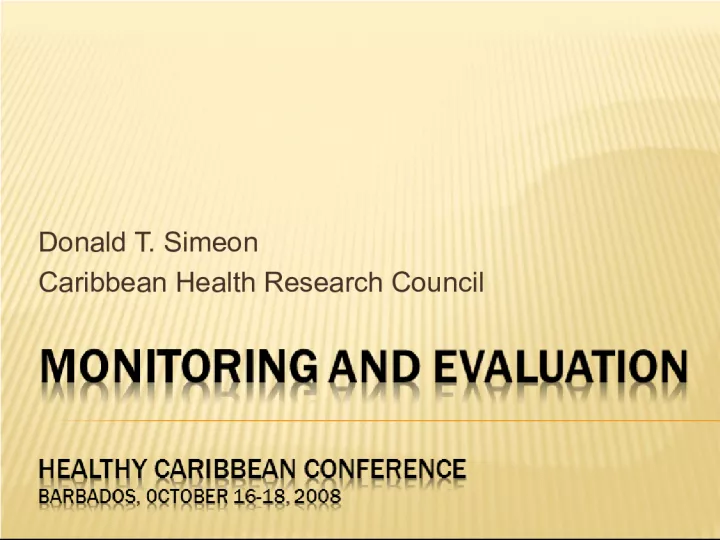

Donald T SimeonCaribbean Health Research Council Monitoring is the routine process of collecting data to measure progress toward program objectives Monitoring involves routinely looking at the way we implement pr
- Uploaded on | 5 Views
-
 sofiasingh
sofiasingh
About Donald T SimeonCaribbean Health Research Council
PowerPoint presentation about 'Donald T SimeonCaribbean Health Research Council'. This presentation describes the topic on Donald T SimeonCaribbean Health Research Council Monitoring is the routine process of collecting data to measure progress toward program objectives Monitoring involves routinely looking at the way we implement pr. The key topics included in this slideshow are . Download this presentation absolutely free.
Presentation Transcript
Slide1Donald T. SimeonCaribbean Health Research Council
Slide2Monitoring is the routine process of collecting data to measure progress toward program objectives Monitoring involves routinely looking at the way we implement programs, conduct services etc. Examines efficiency
Slide3Evaluation is the use of research methods to systematically investigate a program’s effectiveness Evaluation involves measurements over time Need for baseline Sometimes requires a control or comparison group Evaluation involves special research studies
Slide4To ensure that programs are being implemented as designed (fidelity of programme implementation) To ensure the delivery of quality services (continuous quality control - CQI) To ensure that the programmes are making a difference (outcomes) To ensure that programmes and funds are used appropriately and efficiently (accountability)
Slide5Are projects and components of projects (i.e., specific activities) being conducted as planned and on schedule? Done primarily through programme monitoring Examine the implementation of activities relative to a planned schedule Programme monitoring ensures that programs are administered and services are delivered in the way they were designed
Slide6Use information to modify/improve the configuration and implementation of programmes What was learned from implementing the programme that can be improved upon? What went wrong and how can it be corrected next time? What worked especially well and how can those lessons be incorporated into future activities? Did the intervention work? Were the outcomes as expected?
Slide7Are the projects/interventions having the desired effect on the target populations? For example, are health care providers using clinical guidelines as recommended? Done primarily through programme evaluation Determine whether programme/project made a difference (e.g., does the use of guidelines result in decreased rates of complications in diabetic patients)
Slide8Usually examined through studies designed to collect data on logical outcomes from the project/intervention (e.g., periodic surveys of target groups) Did the programs have the expected/desired outcomes? If no, why? Was it a function of implementation challenges or poor project design or a study design that failed to capture outcomes? What are the implications for future interventions? Should they be the same or can they be improved in some way?
Slide9Taxpayers, donor agencies and lenders need to know: funds were used as intended programmes made a difference Evaluation findings document achievements as well as what remains to be done Findings can be used to demonstrate unmet needs and facilitate requests for additional funds.
Slide10funding should be proportional to programme resources ideally about 7% of the program budget needed at all levels most useful if performed in a logical sequence first assessing input/process/output data ( monitoring/process evaluation ), then examining behavioural or immediate outcomes and finally assessing disease and social level impacts . minimize data collection burden and maximize limited resources activities should be well coordinated utilize ongoing data collection and analysis as much as possible
Slide11To increase the utilization of evaluation results, M&E design planning, analysis, and reporting should actively involve key stakeholders programme managers, policy makers, community members, and programme participants M&E indicators should be comprehensive should also measure population-based biological, behavioural, and social data to determine "collective effectiveness"
Slide13Specific measures that reflect a larger set of circumstances Greater emphasis on transparency globally, people want instant summary information, instant feedback Indicators respond to this need
Slide14only indicate – will never capture the richness and complexity of a system Designed to give ‘slices’ of reality encourage explicitness : they force us to be clear and explicit usually rely on numbers & numerical techniques (rates, ratios, comparisons) have specific measurement protocols which must be respected
Slide15Primary Data Sources: Quantitative program data e.g. from coverage of services Surveys: demographic health surveys, epidemiological, behavioral and other studies Research and impact evaluations. Qualitative data from program staff, key informants and direct observation Secondary Data Sources: National response documentation, expenditures reports and program review reports. Surveillance reports Routine statistics e.g. mortality, hospital admissions SOURCES OF DATA
Slide16Program goals and objectives may be vague or overly broad, making indicator selection difficult Indicators should be clearly related to program goals and objectives Program objectives may have multiple indicators Indicators are used at all levels of the programme implementation process Process indicators Outcome indicators Impact indicators
Slide17Impact Indicators are used for national and global reporting e.g. mortality rates Outcomes Program indicators are used for reporting to national authorities and donors. Changes at end of intervention/program period e.g. rate of HBP control among targeted patients, hospital admissions et. Outputs Selected Interventions Indicators (such as approval of a policy, health care professionals trained) are used for programmatic decision making Inputs R esource allocation indicators may be included F inancial, human, material, and technical resources
Slide18How can the main focus of the objective best be measured? What practical constraints are there to measuring the indicator? Are there alternative or complementary measures that should be considered? What resources (human and financial) does the indicator require? Do standard (validated, internationally recognized) indicators exist? How will the results not captured by the selected indicator be measured? ( Indicators are imperfect)
Slide19Indicators should be expressed in terms of: Quantity Quality Population Time For example, an indicator written for the program objective of “I mproving glycemic control in diabetic patients ” might specify: “Increase from 30% to 50% ( quantity ) of gylcaemic control rates ( quality ) among diabetic patients ( population ) by October 2009 ( time ).”
Slide20# care providers trained to use clinical guidelines in the past year % patients with controlled diabetes in health centres % A&E admissions for diabetes related complications
Slide21Simple, clear and understandable Valid – does it measure what it is intended to measure Specific – Should measure only the conditions or event under observation and nothing else Reliable – should produce the same result when used more than once to measure the same event
Slide22Relevant – related to your work Sensitive – will it measure changes over time Operational – should be measurable or quantifiable using definitions and standards Affordable – should impose reasonable measurement costs Feasible – should be able to be carried out using the existing data collection system
Slide23To ensure that programs are being implemented as designed and funds are used appropriately and efficiently To ensure that the programmes are making a difference The selection of appropriate indicators (relative to program objectives) is critical to the success
